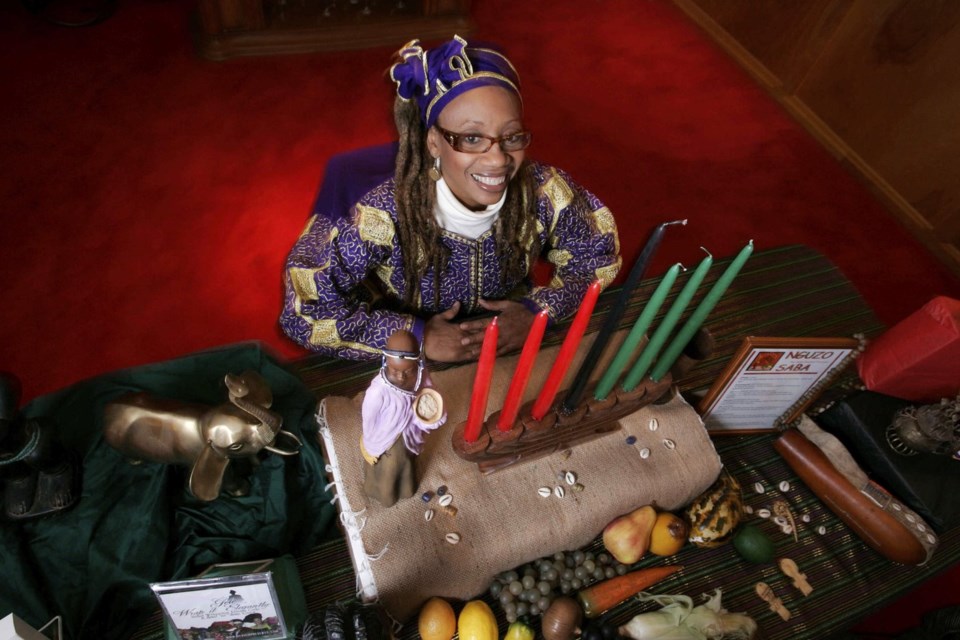Kwanzaa has become a nationally recognized celebration of African culture and community in the United States since its founding in 1966 and also is celebrated in countries with large African descendant populations.
The holiday, which serves as a nationwide communal event reinforcing self-determination and unity in the face of oppression, spans seven days from the day after Christmas through New Year’s Day. It is observed in large, city-sponsored events as well as in smaller communities and homes nationwide.
Kwanzaa has grown in popularity in the decades since its founding and is celebrated by 3% of the country, according to a 2019 AP-NORC survey. Former Presidents Bill Clinton, George W. Bush and Barack Obama all released statements commemorating the holiday, and in 1997 the U.S. Postal Service began issuing Kwanzaa stamps. It is not recognized as a federal holiday.
Kwanzaa’s origins
Kwanzaa emerged during the Black Freedom Movement of the 1960s as a way to reconnect Black communities in the U.S. with important African cultural traditions that were severed by the transatlantic slave trade. It also promotes unity and liberation.
“It was also shaped by that defining decade of fierce strivings and struggles for freedom, justice and associated goods waged by Africans and other peoples of color all over the world in the 1960s,” Maulana Karenga, the holiday’s founder, wrote in his annual Kwanzaa address in 2023. “Kwanzaa thus came into being, grounded itself and grew as an act of freedom, an instrument of freedom, a celebration of freedom and a practice of freedom.”
Karenga, an African American author, activist and professor, founded Kwanzaa following the Watts Riots, also known as the Watts Rebellion, in Los Angeles in 1965.
Karenga described Kwanzaa as a “political-motivator holiday” in an interview with Henry Lewis Gates Jr. for PBS.
“The idea is for African and African descended people to come together around family, community and culture so we can be in spaces where, in Dr. Karenga’s words, we feel fully African and fully human at the same time,” said Janine Bell, president and artistic director at the Elegba Folklore Society in Richmond, Virginia.
The basics
Many people who observe Kwanzaa, which is a secular holiday, celebrate it alongside religious festivals such as Christmas. People of any faith, race or ethnic background can participate.
The name Kwanzaa derives from “mutanda ya kwanza” a Swahili phrase meaning “first fruits” or "first harvest." The final “a” was added to the name to accommodate the seven children present at the first Kwanzaa, each of whom was given a letter to represent.
The holiday is governed by seven principles, known collectively as the Nguzo Saba, and a different principle is celebrated each day: Umoja (Unity), Kujichagulia (Self-Determination), Ujima (Collective Work and Responsibility), Ujamaa (Cooperative Economics), Nia (Purpose), Kuumba (Creativity) and Imani (Faith).
The Nguzo Saba is represented by a candleholder with seven candles called a kinara. Each night, one of those candles is lit. The candles are the same colors as the Kwanzaa flag: Black representing the people, red their struggle and green their hope.
Large Kwanzaa celebrations happen across the country every year in cities including Los Angeles, Atlanta and Detroit. These events often feature storytellers, music and dance.
Bell said the theme at this year's Capital City Kwanzaa Festival in Richmond is “knowledge of self," and an African descendent will be selected by drawing a name from a fishbowl to win a free DNA test so they can learn where they come from.
The holiday is also observed in individual homes, often focusing on children, because they are key to the survival of culture and the development of community. This concept of children and the future they embody is often represented symbolically by corn.
“The intention is that it’s 365 (days a year),” Bell said. “The need for the principles and the strengthening value of the principals don’t go away on January 2nd.”
Family celebrations also involve giving gifts and sharing African American and Pan African foods, culminating in the Karamu, a feast featuring dishes from across the African diaspora. Typical meals include staples of southern cuisine like sweet potato pie or popular dishes from Africa like jollof rice.
Activities over the seven days are geared toward reaffirming community bonds, commemorating the past and recommitting to important African cultural ideals. This can include dancing, reading poetry, honoring ancestors and the daily lighting of the kinara.
Graham Lee Brewer, The Associated Press



